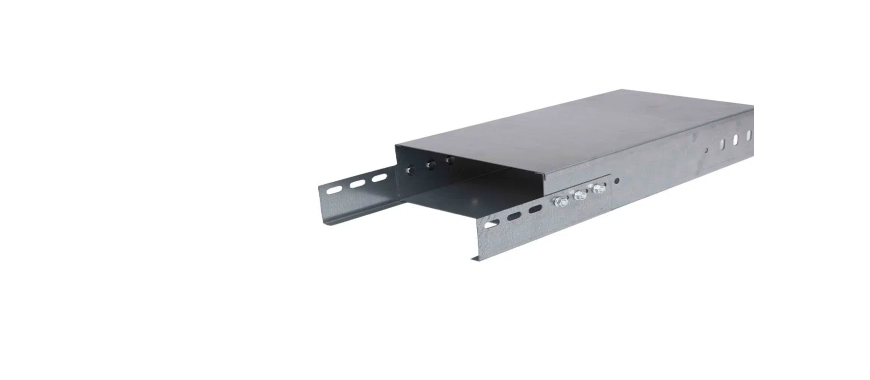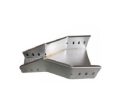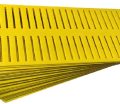
Electromagnetic Compatibility (EMC) is critical in maintaining the reliability of modern electrical systems. EMC ensures that devices operate efficiently without causing or experiencing interference. In structured cabling systems, achieving EMC requires careful planning and the use of effective solutions, such as the EMC cable tray.An EMC cable tray plays a vital role in minimizing electromagnetic interference (EMI) by providing a shield for cabling systems. Proper implementation enhances data integrity and improves overall system performance. EMC coupling further ensures that signals remain clear and undistorted, even in environments with high electrical activity.By understanding the principles of EMC and integrating appropriate practices, the performance and longevity of structured cabling systems can be significantly improved, ensuring efficient and stable operations.
The Role of EMC Cable Trays in Electrical Systems
EMC cable trays are crucial in maintaining electromagnetic compatibility (EMC) within electrical systems. They provide an essential framework for organizing cables while minimizing electromagnetic interference (EMI). Proper installation and design of EMC cable trays enhance system efficiency, reduce signal disturbances, and ensure long-term reliability.
Metal Cable Trays and Their Impact on EMC Performance
Function as a Generalized Shield in Cabling Systems
Metal cable trays act as a generalized shield, providing a physical barrier against external EMI. By enclosing or partially enclosing cabling, they reduce the exposure of sensitive cables to environmental noise. This shielding effect enhances the clarity of transmitted signals and minimizes the risk of cross-talk or interference between cables.
- Factors Influencing Shielding Effectiveness:
- Material Composition: Conductive materials such as aluminum or steel are highly effective in shielding electromagnetic fields.
- Tray Design: Fully enclosed trays offer better protection than ladder trays or perforated designs.
- Installation Location: Proximity to high-power equipment or other EMI sources can influence performance.
- Cable Type: Shielded cables within the tray further enhance compatibility.
- External Environment: Trays in industrial settings face unique EMI challenges compared to residential or commercial environments.
Contributions to EMC Earthing and Grounding
Proper earthing and grounding of EMC cable trays play a vital role in their effectiveness. They create a low-resistance path for stray electromagnetic currents, preventing the buildup of charge that could disrupt nearby equipment.
- Key Benefits of Effective Grounding:
- Minimizes the risk of electrical shock.
- Reduces the likelihood of EMI affecting sensitive equipment.
- Prevents the accumulation of stray currents within the system.
- Improves overall system stability and performance.
- Supports compliance with industry standards and regulations.
How EMC Cable Shielding Improves Performance
Shielding Techniques to Reduce Interference
Effective shielding involves various techniques to mitigate EMI:
- Tray Positioning: Ensuring adequate distance from high-power lines.
- Use of Dividers: Separating power and data cables within the tray.
- Shield Material: Selecting materials with high conductivity for maximum protection.
- Grounding at Multiple Points: Enhancing the dissipation of stray currents.
- Integrating Shielded Cables: Using shielded cables in conjunction with the tray.
Each technique contributes to improved signal clarity and reduced downtime caused by interference-related issues.
Benefits of Maintaining Continuity in Shielding
Maintaining continuity in shielding ensures consistent protection throughout the cable tray system. Interruptions in the shielding can create vulnerabilities that allow EMI to affect performance.
- Advantages of Continuous Shielding:
- Reduces the likelihood of signal degradation.
- Ensures uniform protection across all system components.
- Improves long-term reliability of the system.
- Minimizes the risk of interference from nearby equipment.
- Enhances the effectiveness of EMC earthing practices.
Cable Tray Feeder Installation Tips for Optimal Performance
Installation Practices for EMC Cable Trays
Proper installation practices for EMC cable trays are critical for achieving optimal performance. Attention to detail during installation minimizes interference and enhances the system’s ability to handle electromagnetic disturbances effectively.
Key Factors in EMC Cable Tray Installation
Importance of Proper Bonding and Grounding Practices
Proper bonding and grounding are essential to the performance of EMC cable trays. They ensure that all components are electrically connected and provide a continuous path for current flow.
- Benefits of Proper Bonding:
- Prevents system failures caused by poor conductivity.
- Reduces the risk of localized heating due to stray currents.
- Enhances overall system reliability.
- Improves compliance with safety standards.
- Minimizes noise generated by electrical discharge.
Impact of Poor Bonding on Network Performance
Poor bonding can result in significant performance issues:
- Signal loss due to inadequate electrical connections.
- Increased susceptibility to external EMI.
- Higher risk of overheating in cable tray components.
- Compromised data integrity in sensitive systems.
- Failure to meet industry compliance requirements.
EMC Earthing and Grounding Guidelines
Best Practices for EMC Earthing Connections
Effective earthing connections enhance the performance of EMC cable trays:
- Regular Inspections: Ensure that all connections remain secure and corrosion-free.
- Use of High-Quality Materials: Conductive materials reduce resistance and improve performance.
- Consistent Grounding Points: Grounding at strategic intervals ensures effective dissipation of stray currents.
- Isolation from Non-EMC Components: Prevents interference from unrelated systems.
- Compliance with Standards: Following IEC standards guarantees optimal results.
Good Engineering Practices for EMC Cable Tray
Adopting good engineering practices ensures that EMC cable trays perform efficiently and reliably. Following established standards and incorporating practical insights can optimize installation and performance.
Reference to International EMC Guides and Standards
Steps for Achieving Compliance with Global Directives
Compliance ensures that EMC cable trays meet international standards:
- Understand specific regulatory requirements for the system’s environment.
- Conduct pre-installation assessments to identify potential EMI sources.
- Use approved materials and designs that meet IEC standards.
- Implement shielding and grounding methods as outlined in industry guides.
- Regularly audit the system to maintain compliance over time.
Overview of Standards for EMC Electrical Systems
Key standards provide guidance on maintaining EMC:
- Specifications for cable tray materials and designs.
- Guidelines on grounding and bonding techniques.
- Recommendations for installation in high-EMI environments.
- Testing protocols to assess system performance.
- Maintenance practices to sustain compatibility.
Testing Results and Practical Insights
Results of EMC Performance Tests on Cable Trays
Testing reveals critical insights into the effectiveness of EMC cable trays:
- Improved shielding reduces interference by up to 90%.
- Proper grounding minimizes voltage spikes across systems.
- High-quality materials improve EMI resistance in industrial settings.
- Consistent performance even in environments with fluctuating EMI levels.
- Reduced downtime due to fewer interference-related disruptions.
Importance of Realistic Installation Methods for Optimal Outcomes
Practical installation techniques significantly impact performance:
- Use of accessible grounding points for ease of maintenance.
- Strategic tray placement to avoid high-EMI zones.
- Incorporation of flexible fittings for complex installations.
- Ensuring consistent shielding across entire tray lengths.
- Use of durable materials to withstand harsh environmental conditions.
Adopting best practices for EMC cable tray installation enhances electromagnetic compatibility, improves system reliability, and reduces interference-related issues. Proper shielding, grounding, and adherence to international standards ensure that electrical systems operate efficiently in diverse environments. By implementing these practices, GangLong Fiberglass guarantees robust solutions for managing electromagnetic interference effectively.
Advanced Cable Tray Production Line Technology Explained
Addressing Common EMC Challenges
Electromagnetic compatibility (EMC) challenges can disrupt electrical systems and affect cabling performance. Understanding the nature of EMC disturbances and implementing effective mitigation strategies is essential for maintaining system reliability and functionality.
Types of EMC Disturbances and Their Effects
One-Time, Periodic, and Steady Disturbances
EMC disturbances can manifest in different forms, each with unique impacts:
- One-Time Disturbances:
Sudden events like lightning strikes or power surges introduce high-intensity electromagnetic interference (EMI). These can cause immediate equipment damage, data corruption, or temporary system failure. Preventing such disturbances requires robust shielding and surge protection integrated with EMC cable trays. - Periodic Disturbances:
Generated by devices like motors or generators, these disturbances occur at regular intervals. Over time, they degrade system performance by introducing noise that accumulates within the cabling system. Proper coupling techniques and consistent grounding in EMC cable trays minimize these risks. - Steady Disturbances:
Constant EMI from nearby high-power sources or long-term electromagnetic exposure impacts sensitive cables. This leads to degraded signal quality and reduced transmission efficiency. Continuous shielding and strategic tray placement protect against steady disturbances.
Impacts on Cabling and Electrical System Performance
EMC disturbances can cause:
- Reduced data transmission efficiency due to signal interference.
- Increased likelihood of system malfunctions.
- Higher maintenance costs due to frequent repairs.
- Decreased lifespan of electrical components.
- Loss of productivity caused by system downtime.
Mitigation Strategies for EMC Problems
Practical Recommendations for Shielding and Coupling
Addressing EMC challenges involves implementing effective shielding and coupling methods:
- Strategic Tray Placement: Ensure EMC cable trays are positioned away from high-power equipment. This reduces EMI exposure.
- Use of Dividers: Separate power and data cables to minimize cross-talk and interference.
- Integration of Shielded Cables: Enhance the protection offered by EMC cable trays by using shielded cables for sensitive data lines.
- Continuous Grounding: Maintain uninterrupted grounding to dissipate stray currents effectively.
- Optimized Tray Design: Select fully enclosed or partially shielded EMC cable trays based on the installation environment.
Role of Fittings in Ensuring Continuity and Performance
High-quality fittings are vital for maintaining the continuity and performance of EMC cable trays:
- Durable Materials: Fittings made from conductive materials enhance the tray’s shielding properties.
- Secure Connections: Well-designed fittings ensure all components remain securely bonded, preventing breaks in shielding.
- Flexibility in Installation: Adjustable fittings accommodate complex layouts, ensuring uninterrupted shielding even in challenging setups.
- Ease of Maintenance: Reliable fittings simplify inspections and repairs, reducing system downtime.
- Compliance with Standards: Standard-compliant fittings ensure that EMC cable trays meet regulatory requirements, enhancing overall system performance.
Substation Cable Tray Benefits for Power Infrastructure
Recommendations for EMC Cable Tray Systems
Adopting best practices and ensuring long-term performance are essential for effective EMC cable tray installations.
Best Practices for Installation and Maintenance
Proper Connection of Cable Trays to Cabinets
Connecting EMC cable trays to cabinets correctly ensures efficient EMI management:
- Factors Influencing Connection Quality:
- Secure bonding to eliminate potential EMI gaps.
- Conductive materials for tray-to-cabinet interfaces.
- Regular inspections to ensure lasting connectivity.
- Use of grounding straps for enhanced performance.
- Placement considerations to avoid external EMI sources.
Importance of Husky Cable Tray Fittings in Achieving Good EMC
High-quality fittings like Husky cable tray fittings contribute to EMC optimization:
- Ensure tight seals that maintain uninterrupted shielding.
- Provide corrosion-resistant materials for long-lasting performance.
- Support flexible configurations, simplifying complex installations.
- Enhance tray grounding efficiency through robust design.
- Allow easy integration into existing systems.
Ensuring Long-Term EMC Performance
Steps to Maximize Shielding and Grounding Effectiveness
Ensuring long-term EMC performance involves consistent monitoring and maintenance:
- Regular inspections to identify and address potential vulnerabilities.
- Use of high-quality, conductive materials in all components.
- Continuous grounding at regular intervals to prevent EMI buildup.
- Strategic placement of trays and cables to minimize interference.
- Incorporating advancements in shielding technology to adapt to evolving challenges.
Adherence to IEC Standards for Sustained Compatibility
Compliance with IEC standards ensures the longevity and efficiency of EMC cable trays:
- Guidelines for material selection and installation practices.
- Recommendations for shielding techniques in high-EMI environments.
- Testing protocols to verify system performance under different conditions.
- Maintenance procedures to sustain compatibility over time.
- Clear documentation for regulatory compliance and quality assurance.
Maximizing the Benefits of EMC Cable Tray Systems
Implementing good engineering practices ensures that EMC cable trays deliver consistent performance and reliability.
- Summary of Good Engineering Practices for EMC Optimization:
- Proper installation with attention to grounding and shielding.
- Selection of high-quality materials and fittings.
- Regular testing and maintenance to sustain efficiency.
- Adherence to international standards for compliance and safety.
- Strategic tray placement to minimize EMI risks.
- Key Benefits of Well-Installed EMC Cable Tray Systems:
- Reduced electromagnetic interference and improved signal quality.
- Increased system reliability and performance.
- Enhanced safety through effective grounding practices.
- Longer lifespan for electrical components and reduced maintenance costs.
- Support for compliance with global EMC regulations.
By following these recommendations, systems that incorporate EMC cable trays can achieve optimal functionality and withstand even the most challenging electromagnetic environments. GangLong Fiberglass is committed to offering innovative solutions for managing EMI and ensuring reliable electrical performance.
FAQs about EMC Cable Tray
EMC stands for Electromagnetic Compatibility, and EMC cable refers to cabling systems designed to minimize electromagnetic interference (EMI). These cables are crucial in environments where multiple electronic devices operate, as they ensure that electrical signals remain clear and free of distortion. EMC cables typically feature specialized shielding to block external EMI sources and prevent internal signal leakage. When used in conjunction with EMC cable trays, they provide a comprehensive solution for maintaining system reliability in high-EMI environments, such as industrial facilities or data centers.
Cable trays are classified into three primary types based on their design and application: ladder trays, solid-bottom trays, and perforated trays. Ladder trays consist of two side rails connected by rungs and are ideal for managing heat in heavy-duty installations. Solid-bottom trays provide full enclosure and are used in applications requiring maximum protection from environmental factors like dust or moisture. Perforated trays feature a partially open design that balances ventilation with cable support, making them versatile for general use. Each type can be adapted to suit specific needs, especially when paired with EMC cable trays to mitigate electromagnetic interference.
EMC wiring refers to the practice of organizing and installing electrical wiring systems to minimize electromagnetic interference. This approach involves using shielded cables, proper grounding techniques, and effective cable management solutions like EMC cable trays. The goal is to reduce signal noise and enhance compatibility between interconnected systems. EMC wiring is commonly implemented in environments with sensitive electronic equipment, such as healthcare facilities or manufacturing plants. By following EMC guidelines, wiring systems can ensure data integrity, reliable performance, and compliance with international standards.
A NEMA cable tray is a cable management system designed to meet the standards set by the National Electrical Manufacturers Association (NEMA). These standards define the strength, durability, and application suitability of cable trays used in electrical installations. NEMA cable trays come in various types, including ladder, trough, and channel trays, each tailored to specific environmental and load requirements. When combined with EMC cable trays, NEMA-compliant trays ensure reliable performance in systems where both structural integrity and electromagnetic compatibility are critical. They are widely used in industrial, commercial, and institutional applications to provide safe and efficient cable routing.

As the editor of GangLong Fiberglass, I have years of experience and in-depth research, focusing on cable tray products, fiberglass solutions, and grille systems. I incorporate years of industry insights and practical experience into every content, committed to promoting the progress of the industry. At GangLong Fiberglass, my commitment is reflected in every product, from innovative cable trays to durable fiberglass solutions and sturdy grille systems. As an authoritative voice in the industry, my goal is to provide valuable information to professionals and businesses and promote forward-looking solutions.


